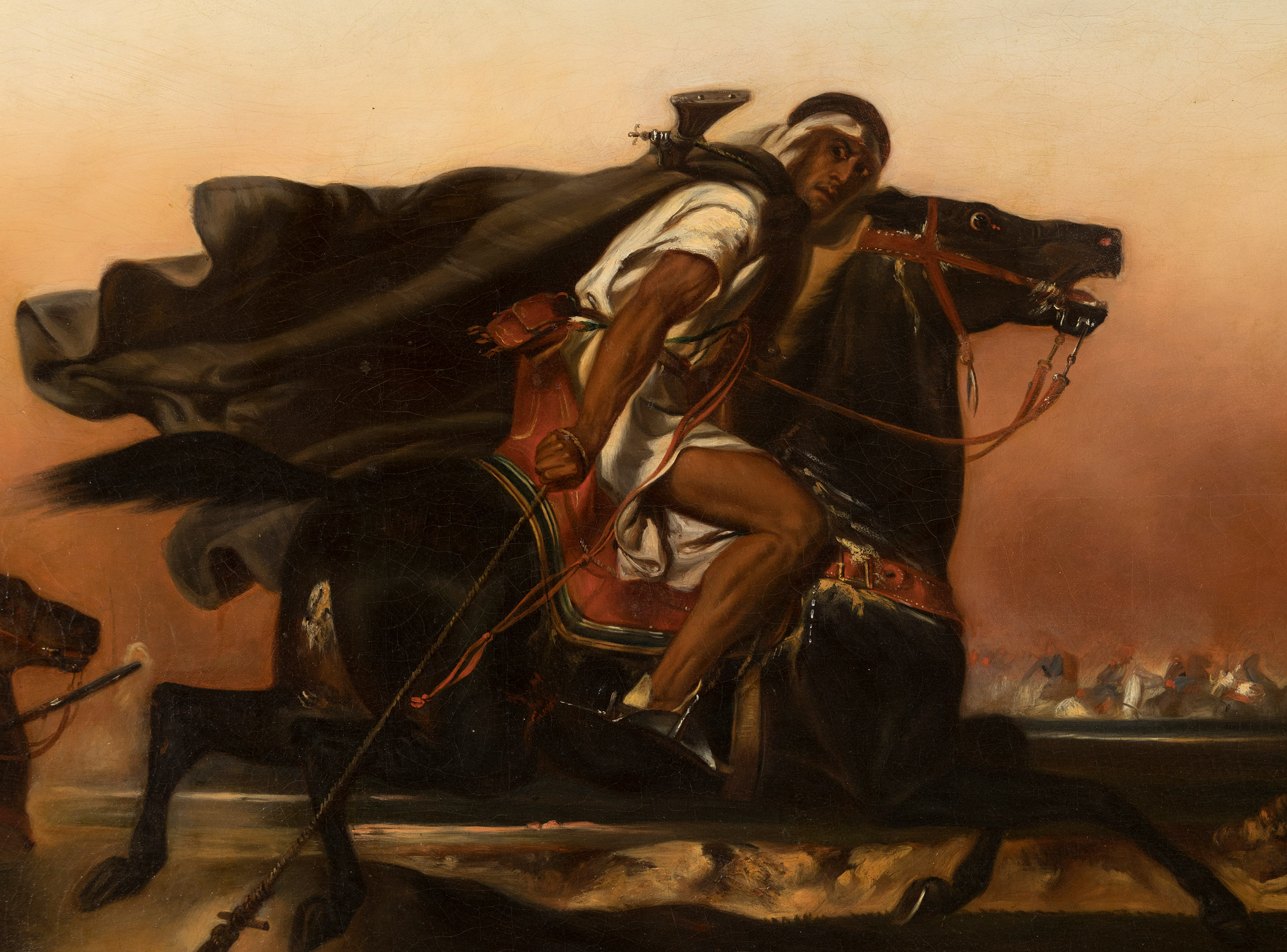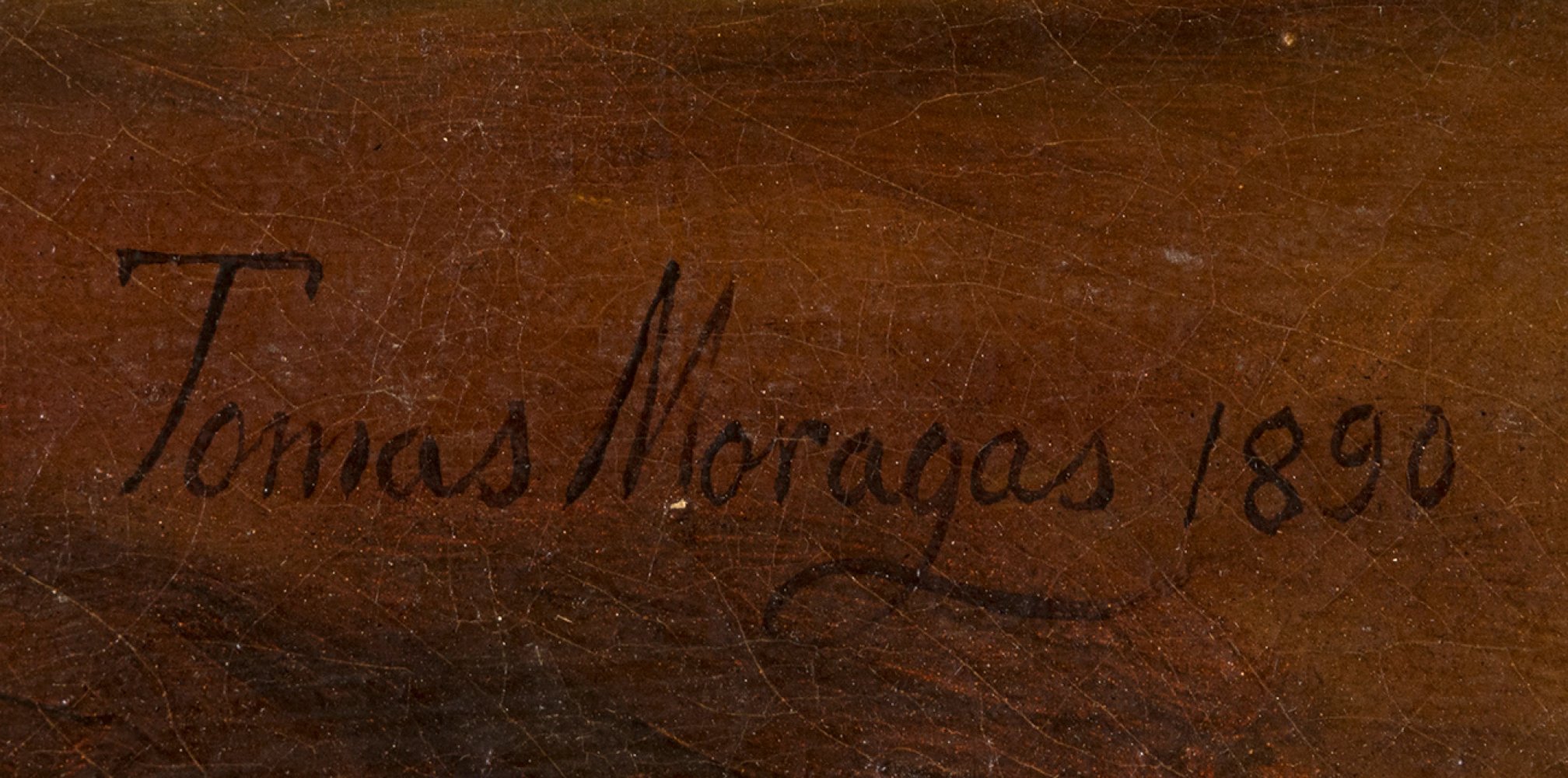2
TOMÁS MORAGAS Y TORRAS (Girona, 1837 - Barcelona, 1906)."The Renegade, 1890.Oil on canvas.Signed and
"The Renegade, 1890.
Oil on canvas.
Signed and dated in the lower left corner.
It has restorations on the sky (left side).
Missing in the frame.
Measurements: 108 x 107 cm.
In this battle scene, the Moroccan horsemen, wrapped in white tunics fluttering in the wind, appear highly idealised, as if they were characters from a legend. Although the artist may have taken the Spanish-Arab clashes that had taken place thirty years earlier as a reference, the painter does not intend to bear witness to a historical conflict but, on the contrary, to distil it into a romantic image with mythical overtones. The din of the battlefield caused by the galloping impetus of a large number of horsemen raises clouds of dust that contribute to plunging the scene into a reverie. Moragas was an Orientalist painter, fascinated by Maghrebi culture and types, and this is evident in the mystery that emanates from the figures. The equine anatomy has been magnificently resolved, as has the atmospheric perspective work, which is evident in the dynamic effect created by the advance of the warriors emerging from the horizon. In the foreground, a dying body lies on the ground. It probably identifies the "renegade" of the title (the one who changed sides). He has been defeated by a horseman whose black cloak distinguishes him from the rest of the Arabs. On the right, the enemy army can be seen in the distance. The chromatic iridescence and the shifts of light sublimate the landscape, while the atmospheric work does not neglect the individualised work of each of the figures, their anatomies, expressions and gestures.
Tomás Moragas moved to Barcelona in his youth, where he began his training working in the workshop of Jose Pomar LLaró, who introduced him to the technique of engraving and goldsmithing. Later he continued his studies at the Escuela de La Lonja, in Barcelona, where he was taught by Claudio Lorenzale and Pablo Milá Fontanals and met Jose Tapiró Y Baró and Mariano Fortuny. He then moved to Rome, where he shared a studio with Mariano Fortuny. After almost a decade in the Italian capital he went to Paris in 1866, where he settled until his definitive return to Barcelona in 1876. In Spain he was an outstanding teacher, founding the School of Watercolourists and teaching at the Sant Jordi School of Fine Arts in Barcelona and at the Academy of Arts and Crafts in Vilanova i la Geltrú, as well as his role as artistic advisor at the Universal Exhibition in Barcelona in 1888. Works by him can be found in the Museo del Prado, the MACBA, the Museo Nacional de Arte de Cataluña and the Museo de Historia de la Ciudad de Barcelona, among many others. His painting is notable for an aesthetic style that follows to some extent the aesthetics of Fortuny, with a theme of mansions, he practised a highly popular commercial style of painting, with representations of an orientalist character, among which the work in the Barcelona Museum of Modern Art is particularly noteworthy.
"The Renegade, 1890.
Oil on canvas.
Signed and dated in the lower left corner.
It has restorations on the sky (left side).
Missing in the frame.
Measurements: 108 x 107 cm.
In this battle scene, the Moroccan horsemen, wrapped in white tunics fluttering in the wind, appear highly idealised, as if they were characters from a legend. Although the artist may have taken the Spanish-Arab clashes that had taken place thirty years earlier as a reference, the painter does not intend to bear witness to a historical conflict but, on the contrary, to distil it into a romantic image with mythical overtones. The din of the battlefield caused by the galloping impetus of a large number of horsemen raises clouds of dust that contribute to plunging the scene into a reverie. Moragas was an Orientalist painter, fascinated by Maghrebi culture and types, and this is evident in the mystery that emanates from the figures. The equine anatomy has been magnificently resolved, as has the atmospheric perspective work, which is evident in the dynamic effect created by the advance of the warriors emerging from the horizon. In the foreground, a dying body lies on the ground. It probably identifies the "renegade" of the title (the one who changed sides). He has been defeated by a horseman whose black cloak distinguishes him from the rest of the Arabs. On the right, the enemy army can be seen in the distance. The chromatic iridescence and the shifts of light sublimate the landscape, while the atmospheric work does not neglect the individualised work of each of the figures, their anatomies, expressions and gestures.
Tomás Moragas moved to Barcelona in his youth, where he began his training working in the workshop of Jose Pomar LLaró, who introduced him to the technique of engraving and goldsmithing. Later he continued his studies at the Escuela de La Lonja, in Barcelona, where he was taught by Claudio Lorenzale and Pablo Milá Fontanals and met Jose Tapiró Y Baró and Mariano Fortuny. He then moved to Rome, where he shared a studio with Mariano Fortuny. After almost a decade in the Italian capital he went to Paris in 1866, where he settled until his definitive return to Barcelona in 1876. In Spain he was an outstanding teacher, founding the School of Watercolourists and teaching at the Sant Jordi School of Fine Arts in Barcelona and at the Academy of Arts and Crafts in Vilanova i la Geltrú, as well as his role as artistic advisor at the Universal Exhibition in Barcelona in 1888. Works by him can be found in the Museo del Prado, the MACBA, the Museo Nacional de Arte de Cataluña and the Museo de Historia de la Ciudad de Barcelona, among many others. His painting is notable for an aesthetic style that follows to some extent the aesthetics of Fortuny, with a theme of mansions, he practised a highly popular commercial style of painting, with representations of an orientalist character, among which the work in the Barcelona Museum of Modern Art is particularly noteworthy.
24th November - 19th & 20th Century Arts & Berlanga´s Privat Collection
Sale Date(s)
Venue Address
General delivery information available from the auctioneer
Setdart offers Worldwide shipping
PICK UP IN ROOM: You can come and pick up your lots in our offices (Barcelona, Madrid or Valencia). At the moment of the withdrawal, you will be able to accept the current conditions of the lot by means of a document that you will sign.
YOU CAN SEND ANOTHER PERSON TO PICK UP: This person must present a signed authorization that you can find in our web page by accessing from BUY AT SETDART- LOGISTICS-DOWNLOAD AUTHORIZATION DOCUMENT. You can also send an e-mail with the requested data in AUTHORIZATION DOCUMENT to admin@setdart.com
Important Information
25% buyer´s premium
OR
21% buyer´s premium at www.setdart.com
Terms & Conditions
The maximum period to pay the lots is 7 working days. You can pay either via bank transfer or with credit card through our platform www.setdart.com (we only accept VISA or Mastercard).
BUYER´S PREMIUM: 22% Hammer price + 21% VAT from the buyer´s premium
If your piece has more than 100 years, our Ministry of Culture requires an export certificate in order for the piece to leave the country. Note that if the piece goes inside the EU, there is no cost for the export certificate. If the piece goes outside the EU, there is a cost for the export certificate. You can find more information in our Ministry of Culture website: https://www.culturaydeporte.gob.es/en/cultura/patrimonio/exportacionimportacion/exportacion/tasas.html
INQUIRIES: admin@setdart.com
Setdart guides you through the entire process, from the time of award to the day you receive your lot. Our logistics team will be happy to manage your transport, and will advise you on the best shipping method with professionals from the sector used to handling works of art and jewelry.
WE OFFER WORLDWIDE DOOR TO DOOR SHIPPING
PICK UP IN ROOM: You can come and pick up your lots in our offices. At the moment of the withdrawal, you will be able to accept the current conditions of the lot by means of a document that you will sign.
YOU CAN SEND ANOTHER PERSON TO PICK UP: This person must present a signed authorization that you can find in our web page by accessing from BUY AT SETDART-LOGISTICS-DOWNLOAD AUTHORIZATION DOCUMENT. You can also send an e-mail with the requested data in AUTHORIZATION DOCUMENT to admin@setdart.com
SETDART IS NOT RESPONSIBLE FOR THE STATE OF THE PARTS ONCE THEY LEAVE OUR FACILITIES. MRW SHIPMENTS: Once the payment is made, your lot will be packed for shipment, the logistics department will send you an e-mail notifying you of the day it leaves our warehouse, changes of address cannot be made after receiving this e-mail.
INSURANCE INCIDENTS: Coverage for the value of the auction up to 3000 ? per shipment, if the value of the auction is higher, Setdart will send you a quote including the additional insurance. The insurance company WILL NOT BE RESPONSIBLE FOR THE SHIPMENT THAT EXCEEDS THAT AMOUNT AND IS NOT FULLY INSURED. MRW INCIDENTS: Maximum notification 48 hours after receipt, after which the insurance company WILL NOT BE RESPONSIBLE AND NO CLAIMS WILL BE ACCEPTED.
E-MAIL LOGISTICS: logistica@setdart.com
PICK UP YOUR MESSAGES: You can send your own messaging, prior notice via e-mail that your shipment is ready, please note 3 or 4 days in advance. This type of shipment is packaged so Setdart will provide you with a quote.
EXPENSES FOR STORAGE: We inform you that if the purchased lot is not picked up within a month, you will be charged 30€ per week per lot. Setdart Online S.L., owner of the web site "setdart.com", "setdart.net" and "setdart.org", acts as a company of Spanish nationality inscribed in the Volume 36955, sheet 182, page B-293056 of the Mercantile Registry, with registered office at Calle Aragó












